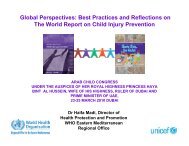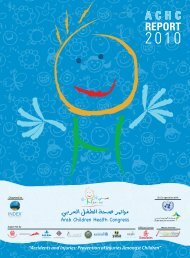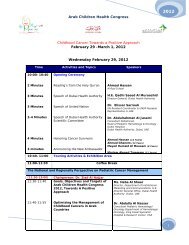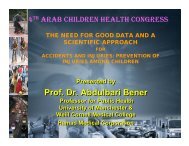Economic Costs of Children's Injuries and Violence
Economic Costs of Children's Injuries and Violence
Economic Costs of Children's Injuries and Violence
Create successful ePaper yourself
Turn your PDF publications into a flip-book with our unique Google optimized e-Paper software.
<strong>Economic</strong> <strong>Costs</strong> <strong>of</strong> Children’s<br />
<strong>Injuries</strong> <strong>and</strong> <strong>Violence</strong><br />
Dr. Mahendra Sheth<br />
Regional Health Advisor<br />
UNICEF Regional Office for Middle<br />
East <strong>and</strong> North Africa
Definitions<br />
<strong>Violence</strong><br />
• Intentional use <strong>of</strong> physical<br />
force or power,<br />
– threatened or actual, against<br />
oneself, another person,<br />
– or against a group or<br />
community,<br />
– that either results in or has a<br />
high likelihood <strong>of</strong> resulting<br />
in injury, death,<br />
psychological harm,<br />
maldevelopment or<br />
deprivation (WHO)<br />
Injury<br />
• Physical damage that<br />
results when<br />
– a human body is suddenly<br />
subjected to energy in<br />
amounts that exceed the<br />
threshold <strong>of</strong> physiological<br />
tolerance –<br />
– or else the result <strong>of</strong> a lack <strong>of</strong><br />
one or more vital elements,<br />
such as oxygen
<strong>Violence</strong><br />
• interpersonal violence<br />
• suicidal behaviour <strong>and</strong> armed conflict.<br />
• threats <strong>and</strong> intimidation<br />
• less obvious :<br />
– psychological harm,<br />
– deprivation <strong>and</strong> maldevelopment<br />
– compromise well‐being <strong>of</strong><br />
• individuals,<br />
• families<br />
• communities
<strong>Injuries</strong><br />
Unintentional <strong>Injuries</strong>:<br />
• RTA<br />
• Burns<br />
• Electrocution<br />
• Falls<br />
• Poisoning<br />
Intentional injuries:<br />
• Physical<br />
• Sexual<br />
• psychological<br />
• Deprivation or neglect
Interpersonal <strong>Violence</strong><br />
• Disproportionately affects LIC <strong>and</strong> MIC<br />
• Scarcity <strong>of</strong> data LIC/MIC<br />
• Comparisons with HIC complicated<br />
– economic loses with productivity undervalued in<br />
LIC/MIC<br />
• Homicide –<br />
– $15,319 in S. Africa;<br />
– $602,000 in Australia<br />
– $829,000 in NZ<br />
– >2 million in USA
Cost <strong>of</strong> <strong>Violence</strong> in Latin America<br />
Country<br />
• Brazil<br />
• Columbia<br />
• El Salvador<br />
• Mexico<br />
• Peru<br />
• Venezuela<br />
• 10.5<br />
• 24.7<br />
• 24.9<br />
• 1.3<br />
• 5.1<br />
• 11.8<br />
% GDP loss
Importance <strong>of</strong> <strong>Injuries</strong><br />
<strong>Injuries</strong><br />
• Responsible for 950,000<br />
child deaths<br />
• millions require hospital<br />
care<br />
• Many left with disabilities,<br />
<strong>of</strong>ten lifelong.<br />
• The burden <strong>of</strong> injury on<br />
children falls unequally.<br />
– heaviest among the poor with<br />
greatest burden on children<br />
in the poorer countries w/<br />
lower incomes<br />
<strong>Violence</strong><br />
• Over 1.6 m deaths /yr<br />
• Many are injured <strong>and</strong><br />
suffer physical, sexual,<br />
reproductive <strong>and</strong> mental<br />
health problems.<br />
• <strong>Violence</strong> major burden on<br />
national economies<br />
costing billions <strong>of</strong> dollars.<br />
• Largely ignored as a public<br />
health problem
<strong>Economic</strong> costs ‐ injuries<br />
<strong>Injuries</strong><br />
• Enormous – 1‐2% <strong>of</strong> GDP<br />
= 100 billion USD in<br />
developing countries<br />
• Medical costs <strong>and</strong> loss <strong>of</strong><br />
productivity – 0‐14 yrs<br />
from all injuries = 50<br />
billion USD<br />
• More research is needed in<br />
cost <strong>and</strong> cost analysis <strong>of</strong><br />
injuries<br />
<strong>Violence</strong><br />
• USA 3.3% <strong>of</strong> GDP.<br />
• $40.2 billion annually –<br />
Engl<strong>and</strong> <strong>and</strong> Wales<br />
• Scarcity <strong>of</strong> studies <strong>and</strong><br />
data from Low & MIC<br />
• Cost <strong>of</strong> violence depends<br />
on its impact<br />
– lead to loss <strong>of</strong> productivity<br />
– psychosocial trauma<br />
– treatment, etc.
Child Injury Deaths
Road Traffic Accidents (RTA)
RTA<br />
• >40% <strong>of</strong> deaths HIC (also poor countries)<br />
• Some750 child deaths /day(pedestrians,<br />
cyclists, passengers)<br />
• In HIC ‐ mortality declining (safety belts,<br />
child safety seats, bike helmets, tougher law<br />
enforcement <strong>and</strong> better health care).<br />
• >95% <strong>of</strong> all injury deaths in children in low<br />
<strong>and</strong> MICs
RTA facts<br />
• >1.2 million deaths/yr<br />
• > 50 m injured or disabled every year<br />
• 50% <strong>of</strong> victims ‐ vulnerable road users such<br />
as pedestrians, cyclists, <strong>and</strong> motorcyclists<br />
• cost countries up to 4% <strong>of</strong> GNP<br />
• Correctly used seat‐belts reduce the risk <strong>of</strong><br />
death in a crash by 61%
<strong>Economic</strong> costs <strong>of</strong> RTA<br />
• Global loses – 518 billion/year<br />
– Low & MICs – 65 ‐100 billion per year (3% GNP)<br />
– Cost <strong>of</strong> injuries among children alone not known<br />
• Direct <strong>and</strong> Indirect costs:<br />
– permanent disabilities;<br />
– loss <strong>of</strong> schooling;<br />
– medical care;<br />
– legal costs;<br />
– vehicle repair costs;<br />
– loss <strong>of</strong> income to parents,
Long term economic costs<br />
• Premature death<br />
• Rehabilitation<br />
• Loss <strong>of</strong> healthy years<br />
• Inability to work to full extent<br />
• Poorest –<br />
– hardest hit – further decline into poverty<br />
(India/ Bangla Desh studies)<br />
– Caring for injured – costs, workload, etc.<br />
– Sale <strong>of</strong> assets
RTA facts<br />
• M<strong>and</strong>atory use <strong>of</strong> child restraints can reduce<br />
child deaths by 35%<br />
• Helmets reduce fatal <strong>and</strong> serious head injuries<br />
by up to 45%<br />
• Enforcing a drinking <strong>and</strong> driving law around<br />
the world could reduce alcohol‐related crashes<br />
by 20%<br />
• Cost <strong>of</strong> SMS <strong>and</strong> use <strong>of</strong> mobile phones when<br />
driving???
Drowning<br />
• 28% <strong>of</strong> unintentional injury deaths in<br />
children<br />
• 388,000 deaths in 2004<br />
• 45% ‐ children under 20<br />
• 1‐4 year age groups greatest at risk<br />
• Significant regional variations<br />
• 6x higher in LIC/MICs than HIC
Fatal Drowning Rates per 100,000 children by age <strong>and</strong><br />
by country income level, World 2004<br />
12<br />
10<br />
8<br />
6<br />
4<br />
HIC<br />
LIC<br />
2<br />
0<br />
Risk factors<br />
• Densely populated countries with large<br />
open waters<br />
• Gender – boys more affected than girls<br />
• Age –
<strong>Economic</strong> <strong>Costs</strong><br />
• Non fatal drowning costs depend on<br />
severity <strong>of</strong> injury<br />
• Range from 13‐14 thous<strong>and</strong> USD per case<br />
• Severe cases with long term damage – USD<br />
100,000 or more<br />
• Indirect costs to the family not computed<br />
• More data is required to determine true<br />
extent
Burns<br />
• >310,000 people died in 2004<br />
• 96,000 (30%) children fatally injured<br />
• Fire related deaths high cause <strong>of</strong> mortality<br />
in children 1‐9 yrs<br />
• Death rate 11x higher in LIC & MICs<br />
• 10% <strong>of</strong> all unintentional injury deaths
Fatal fire‐related burns
Child Related factors<br />
• Gender 4.9/100,000 in girls vs 3/100,000 in<br />
boys<br />
• Age –
Agent related factors<br />
• Unsafe equipment – heat/light sources;<br />
cooking equipment<br />
• Flammable substances<br />
• Fireworks<br />
• Environmental factors :<br />
– Cooking <strong>and</strong> living areas<br />
– Socioeconomic factors<br />
– Time <strong>of</strong> incident<br />
– Lack <strong>of</strong> access to water
<strong>Economic</strong> <strong>Costs</strong><br />
• Short term <strong>and</strong> long term costs<br />
– Treatment costs<br />
– Caring costs<br />
– Rehabilitation costs<br />
– Psychological trauma<br />
– Impact on families <strong>and</strong> communities<br />
– Loss <strong>of</strong> school days<br />
• Cost <strong>of</strong> treatment varies – $ 1187 ‐ $4102
Falls<br />
• 424,000 <strong>of</strong> all ages died in 2004<br />
• 47,000 children <strong>and</strong> youth
Related factors<br />
• Age: highest in
<strong>Economic</strong> costs<br />
• Most <strong>of</strong> the data is from HIC<br />
• 630 m C$ in 1995<br />
• 95 billion in USA<br />
• Data from LIC <strong>and</strong> MIC is missing.<br />
• More work is needed in getting accurate <strong>and</strong><br />
up to date data <strong>and</strong> economic ramifications
Poisoning<br />
• 346,000 deaths in all ages in 2004<br />
• 45,000 deaths annually in children <strong>and</strong> young<br />
people<br />
• Global rate
Key Approaches to Addressing Childhood <strong>Injuries</strong>
Conclusions<br />
• Child injuries/violence area major public<br />
health issue<br />
• <strong>Injuries</strong> affect child survival<br />
• Children are susceptible to injuries<br />
• Child injuries <strong>and</strong> violence can be prevented<br />
• Cost <strong>of</strong> doing nothing is unacceptable<br />
• Few countries have good data
Conclusions<br />
• Research is limited<br />
• Too few practitioners<br />
• Child injury <strong>and</strong> violence prevention is<br />
responsibility <strong>of</strong> many sectors<br />
• This area <strong>of</strong> child survival is underfunded<br />
• Awareness needs to be created <strong>and</strong> maintained<br />
• Unless these emerging issues are addressed,<br />
the gains towards MDGs may be reversed
Recommendations<br />
• Develop <strong>and</strong> implement a prevention policies<br />
<strong>and</strong> plan <strong>of</strong> action<br />
• Implement specific actions<br />
• Strengthen systems<br />
• Enhance quality <strong>and</strong> quantity <strong>of</strong> data<br />
• Define priorities for research<br />
• Raise awareness
Involve<br />
• International org <strong>and</strong> donors<br />
• Governments<br />
• Private sector<br />
• Media<br />
• Teachers <strong>and</strong> community leaders<br />
• Parents<br />
• Children <strong>and</strong> young people
References<br />
• 2002 World Report on <strong>Violence</strong> <strong>and</strong> Health –<br />
WHO<br />
• The <strong>Economic</strong> Dimensions <strong>of</strong> Interpersonal<br />
<strong>Violence</strong> –WHO 2004<br />
• 2005, WHO <strong>and</strong> UNICEF call for exp<strong>and</strong>ed<br />
global effort to prevent child injury<br />
• UN Secretary General’s Study on <strong>Violence</strong><br />
Against Children 2006<br />
• 2009 joint WHO/UNICEF World report on child<br />
injury prevention







